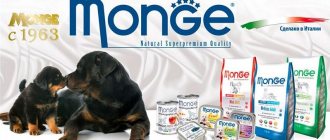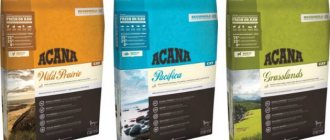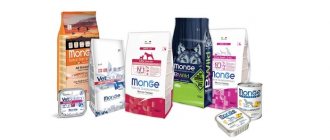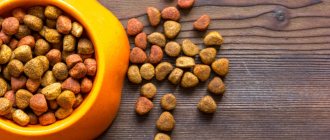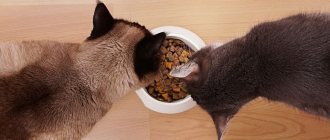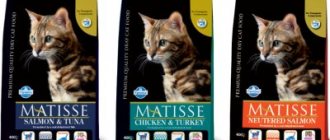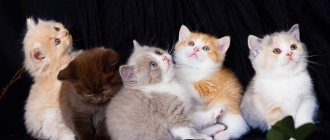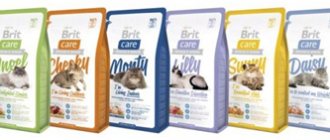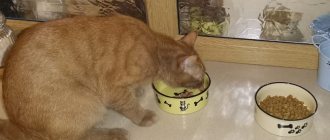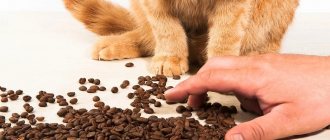12684Administration
A cat's diet before and after castration has significant differences. Changes in hormonal levels lead to obesity in castrates and the development of urolithiasis. Can a neutered cat be given fish? The animal's menu must be balanced in terms of protein, vitamins, microelements, and calories.
Cats and cats, if trained, get used to fish and can go on a “hunger strike”, demanding their favorite product. However, such nutrition is harmful for them, especially after castration, despite the prevailing stereotype of feeding pets.
Is it possible to feed a neutered cat fish?
There is an assumption that after castration, the likelihood of developing urolithiasis may increase. Therefore, most veterinarians, after surgical intervention, advise owners to completely exclude fish products from the menu of a castrated cat in order to prevent the development of serious pathology.
Still, many experts believe that it is permissible to eat fish, but very infrequently, once every 14 days, boiled and in small quantities. However, it is worth observing the following requirements: low-calorie products, always boiled and not raw meat, and also the absence of extra pounds. at the pet's.
Pixabay.com
Symptoms of diseases caused by a fish diet
The root cause of all cat diseases after castration is improper nutrition with excess calories and protein. Determining whether a cat is overweight is simple:
- when stroking, you cannot feel the ribs and spine;
- there is no “waist” between the sternum and hips;
- hanging belly with folds.
Urolithiasis - the formation of sand, stones in the kidneys, bladder has the following symptoms:
- frequent or prolonged urination;
- pink urine;
- painful meowing;
- excessive cleanliness under the tail.
Every fourth cat suffers from urolithiasis; the percentage of cats with urolithiasis due to castration is even higher.
© shutterstock
Initial signs of hyperthyroidism:
- hyperactivity;
- sloppiness;
- increased appetite;
- weight loss;
- cardiopalmus.
Often this disease affects cats after castration over 7 years of age. The cause of its occurrence is not only raw or boiled fish, but also canned fish from iron cans.
Is it possible to feed a sterilized cat fish?
Why can't cats eat fish? Sterilization implies many restrictions on the cat’s diet, and especially on fish products. The absorption of elements slows down, and there is a tendency to become overweight. Because of this, veterinarians recommend excluding fish from the menu of a sterilized pet.
For such cats, it is possible to prepare porridge, purees, and soups in fish broth. It is allowed to supplement the menu with vegetables and herbs.
Pixabay.com
What kind of fish can you give your cat?
A large number of breeders are interested in the question: is it possible to feed a cat fish and how much to give? Your pet should eat fish once every 7 days. However, these must be different varieties. When selecting products for a cat’s diet, you need to take into account the age and well-being of the animal, and what it eats best. Pets are allowed to feed sea and river fish, although the choice falls on one option.
Names of fish that are best to feed cats:
- pollock;
- hake;
- cod;
- salmon;
- trout.
When selecting, it is necessary to take into account the type of product on the pet’s menu, such an indicator as the animal’s obesity. If he is rapidly gaining extra pounds, then it is unacceptable to give him fatty fish options, such as sardines, mackerel, and herring. For large pets, low-fat varieties are better - hake, pollock or cod. These dietary seafood are low in fat, but also low in vitamins A and D.
If a cat expecting offspring eats a white product, then this can become the basis for a deficiency of vitamins in the body. It is advisable to give pregnant fluffies less often, about once every 14 days, red fish, due to the higher content of nutritional omega acids and vitamin components. Many owners completely exclude all types of seafood from the cat menu if they are planning to become mothers, believing that these products are harmful during the period of gestation of kittens.
Diet preparation
A properly composed diet is an opportunity to prevent urolithiasis and obesity.
In the first days, portions should be a third of the usual dose.
The cause of the disease may be an excess of:
- Vitamin A (found in cheese, liver, butter).
- Glutamic acid (found in seafood, fish, tomatoes).
- Magnesium (found in nuts, beans, chocolate).
- Phosphorus (found in eggs, fish, peas, corn).
Benefits and harms
So, is it still possible to pamper your pet with treats made from red and white fish, or is there no point in taking such risks? To understand this issue, you need to familiarize yourself with the beneficial and harmful properties of such a product.
Among the main beneficial qualities of fish are:
- contains easily digestible protein in the structure;
- high% of vitamins A and B;
- there is a large amount of phosphorus and magnesium in the structure;
- fatty fish can act as a source of Omega-3 acid.
However, fish has many more harmful properties:
- Causing damage to the kidneys. The high percentage of salt contained in the structure of the product negatively affects the functioning of this organ. Often, pets who are given fish suffer from urolithiasis, since the presence of phosphorus and magnesium in the structure contributes to the appearance of urinary stones.
- Increased risk of developing helminthiasis. Against this background, damage occurs to the liver, gallbladder and pancreas. Often, helminthic infestation is provoked by an incorrect cat menu. It is unacceptable to feed a purring pet raw fish that was caught in the river.
- The development of hypovitaminosis, which appears against the background of the presence in the structure of many types of product, the enzyme thiaminase, which destroys B vitamins. Subsequently, the animal begins to suffer from anemia.
- A decrease in the content of vitamin E in the body, which occurs against the background of regular addition of this product to the cat’s menu.
- A significant number of bones, which is often used as a motive to injure the throat and stomach area of the pet.
Why can't these animals fish? One of the reasons is the content of destructive thiaminase in the structure of many varieties of fish. It promotes the destruction of vitamin B. To destroy the dangerous substance, you need to cook the fish for at least 10 minutes.
Pixabay.com
Dry cat food
If a novice breeder does not have enough time or knowledge to keep a pet on a natural diet, you can feed it with ready-made food. Their use greatly simplifies the procedure of feeding a pet; however, there are rules that must be followed so as not to harm the cat’s well-being.
It is strictly not recommended to give animals cheap food that is sold in every grocery store. They are made from low-quality ingredients and contain dyes and flavoring additives that are detrimental to the animal’s well-being (prolonged consumption of such feeds provokes the development of urolithiasis). Also, additives in cheap food provoke addiction, and in the future it will be difficult to switch your furry friend to normal nutritious food.
You need to purchase professional food. Their price is significantly higher, but it is completely justified. This food has a balanced structure, is made from high-quality products (usually meat and cereals), and has no dyes or flavoring additives. A large assortment of products makes it possible to choose food depending on the age category, what they like best, breed, and state of health of the animal.
Pixabay.com
Wet food and canned food
These foods are excellent for kittens and older cats.
An alternative to dry food is moistened food and canned food. They contain all the elements required for pets and have a balanced structure, are also easier to chew and are suitable for kittens, older cats and pets with a sensitive digestive system. Canned food is produced in single-use packages and cans, their humidity reaches 85%, so cats drink less water when fed wet food.
The disadvantages of wet food include a shorter shelf life than dry food and the need to store open packaging in the refrigerator. When purchasing such food, you should carefully inspect the packaging - it should not have any swelling, damage, or traces of rust; the expiration date of the food should also be checked.
Freepik.com
Features of animal nutrition after surgery
The cat begins to experience a constant feeling of hunger and the owners simply need to reconsider their diet.
Moreover, this must be done well in advance, before the operation, so as not to make sudden changes during feeding. IMPORTANT! Veterinarians generally do not recommend changing dietary directions. If before the operation the cat was fed natural products, adjust the diet based on them. If industrial formulations were used, it is necessary to select food for sterilized cats from these lines. Sudden changes will bring discomfort and negatively affect the psycho-emotional state of the pet.
What else needs to be considered when feeding cats?
- Periodicity. As already noted, there should be no sudden changes in diet. If previously the cat received food twice a day, this regime must be maintained after surgery. However, the general recommendation is to feed often, but little by little. This will allow the pet not to feel hungry, and the digestive tract will be loaded steadily and evenly, which will allow the metabolism to be adjusted to a comfortable level.
- Providing water. In addition to specialized food for sterilized pets, it is important to take care of a sufficient amount of water. The cat should always have free access to it. This is especially important if the diet contains a large amount of dry food.
- Cats are hereditary carnivores, which means their stomach is adapted to digest meat even after surgery to remove the reproductive organs. You should not focus only on cereals and fiber. About 80% of the diet should be given to protein , preferably of animal origin.
Is it possible to give a cat smoked, salted fish or river fish with bones?
Experts strongly recommend against feeding your pets smoked and salted products. Smoked meat is quite difficult for a furry pet and has a negative effect on the liver. Subsequently, the manufacture of such a product creates carcinogens that negatively affect the gastrointestinal tract and provoke the development of tumors. Salted fish contains a large amount of salt, which is contraindicated for pets. Excess salt may cause cramps, diarrhea, excessive urination, lethargy and increased thirst. The animal can die within 24 hours.
Fish with bones from fresh water should not be fed to pets. The bones themselves become the cause of most diseases and visits to the veterinarian:
- the bones can harm the throat when the animal begins to chew fish fillets;
- sharpened fragments can scratch the stomach when passing through it and are a cause of injury and bleeding;
- In the gastrointestinal tract of a cat, pointed bones provoke an inflammatory process or sepsis.
It is possible to remove a fish bone from a pet's body only under general anesthesia, however, an x-ray will need to be taken in advance.
Before feeding your pet fish, be sure to cut off the fins and gills. They can damage the pet’s internal organs - injure the walls, and thus cause bleeding and digestive disorders.
Pixabay.com
How to stop a cat from eating fish
It is necessary to replace fish protein with meat protein. But what should cat breeders do, who, due to their inexperience, always gave them fish, and now they refuse other food? Could this mean that there is no need to change anything, and let this product remain in the diet? Definitely not. It is necessary to wean the animal off it, but this should not be done immediately, so as not to cause mental trauma to the purring pussy. It is necessary to understand that it is very difficult to overcome an addiction to fish, but by correctly replacing fish protein with meat protein, you can quickly achieve results, and you will not need to endanger the well-being of your furry friend.
By the way, by choosing boiled fish on your pet’s menu, if he really loves this seafood, you can give him ready-made fish-flavored food. It turns out that for ready-made complementary foods, the products undergo special processing cycles, and for taste and aroma they are supplemented with completely safe fish meal, in optimal quantities. And, Omega-3 and Omega-6 fatty acids from the fish structure can be easily replaced with additional vitamin components and supplements.
Taking into account all these suggestions, you can ensure that the fish on your pet’s menu will be a treat for him to enjoy, and not food that could threaten his life and health.
Did you like the recipe?
Healthy foods
Half of the diet is made up of proteins, the rest is made up of carbohydrates with fiber and fats.
It includes the following “dishes”:
Poultry, rabbit, beef. This is the basis of nutrition, it is given daily in boiled form, raw food is pre-frozen for 5 - 6 days. Before feeding, cut into pieces. Minced meat is allowed if you prepare it yourself; store-bought stuffing is too fatty. Fresh meat is not fed to avoid infection with helminths.
By-products: lung, kidneys, liver. They contain nutrients that are not found in muscle fibers; they are also frozen or boiled and included in the diet 2 times a week.
Meat broths. It is useful to accustom sterilized pets to this dish: they need an increased amount of liquid, but they are reluctant to drink water.
Vegetables: zucchini, carrots, pumpkin, cabbage. The boiled product is crushed into puree, the raw product is grated. If the pet refuses vegetables in their pure form, they are mixed with chopped meat or broth.
Fermented milk products up to 10% fat. Ryazhenka, sour cream, kefir, yogurt without fillers, and cheese are suitable.
Porridge: rice, barley, wheat, buckwheat. A teaspoon is added to meat or offal. If the animal refuses, then it is replaced with bran.
Vegetable oil, butter. Add 2-5 drops to food to maintain normal coat condition and improve stomach function.
It is useful to sprout greens from wheat grains, oats, or buy ready-made grass at a pet store. Vitamin and mineral supplements are given only on the recommendation of a veterinarian.
